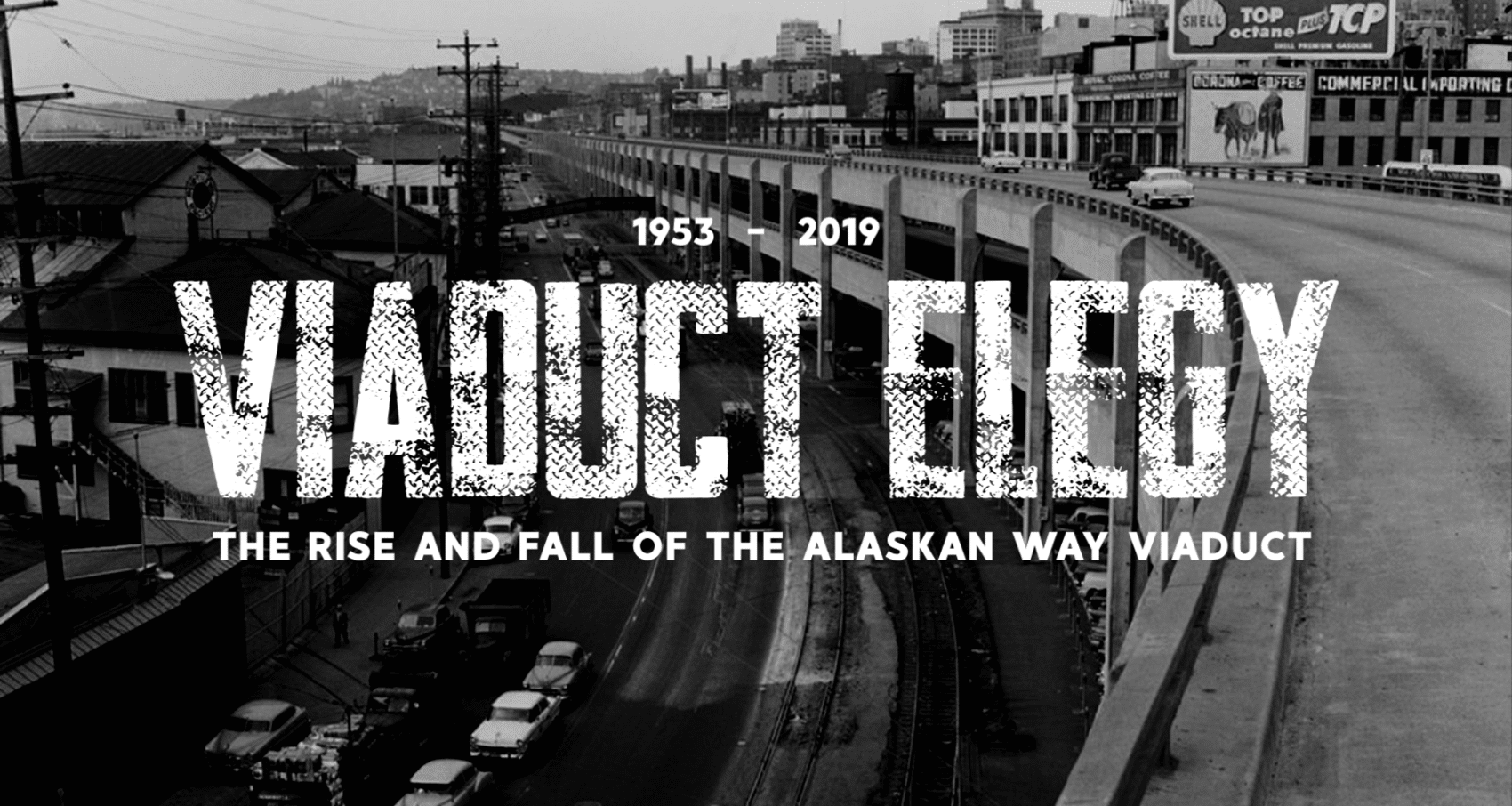Viaduct Elegy is a four-part series from Automoblog feature columnist Tony Borroz, who broke the law in preparation for writing it. He is a Seattle native and author of The 2018 Indy 500 Notebook and Bricks & Bones: The Endearing Legacy and Nitty-Gritty Phenomenon of The Indy 500, available in paperback or Kindle format. Tony grew up in a sportscar-oriented family, but sadly, they were British cars.
Finally, finally, finally they are tearing down the Alaskan Way Viaduct, a colossal, monumentally-ugly, seismically-catastrophic piece of transportation “infrastructure” that has been a scar on the face of Seattle for the better part of a friggin’ century.
And yesterday I walked on it at sunset with an old friend, apparently breaking the law.
Viaduct Elegy: Chapter 1: Walking With Blaine
Most of my friends are artists. Painters, sculptors, photographers, raconteurs, theater types, dancers, gallery impresarios, experience technicians, graphic-novel slingers, art professors, filmmakers, experimental composers; a clan of asymmetric polymath misfits that fit in nowhere else but The Art World.
Chief among these is my friend Blaine. I’ve known him since college, when we were in a punk band together. He taught me to skate. He’s a good guitarist and an even better graphic designer, having a savant-like affinity for fonts and what “looks” and “works” and what would not do either justice. Spending time with Blaine, especially when we’re going from gallery to gallery, is a non-stop conversation about art. What it is and how it works. How it doesn’t work. How this painting fits in with what trends are going on, locally, globally, and historically. Blaine’s commentary is to the point and efficient. It’s the kind of conversation that two mechanics would have; we’re both speaking the same language and we use a lot of shortcuts.
“Well, no, not Picasso so much – Look, I’m not saying the guy shouldn’t go all Guernica, but . . . ”
Northwestern Charm & The End Times
Blaine has an arid sense of humor I always figured he picked up from his dad, a former fighter pilot and commander of a wing of intercontinental ballistic missiles. That drawled-out, dry punch line is never emphasized, only hinted at. His entire family are wise-cracking wisenheimers, and that trait landed on Blaine pretty hard. This is also a trait shared by most Northwesterners. It’s a great way to counteract the abysmal weather and to start bar fights with crab fishermen.
So, here we are, walking through downtown Seattle on a fine, sunny Saturday afternoon. Everything is eerily quiet and rather sparsely populated. Most times, there would be people out in droves, but on this weekend, the city, civic leaders, roadway engineers, priests, rabbis, and ministers all cried out “Stay away from downtown Seattle! Traffic will be terrible. The end is nigh! The Viaduct is closing!”
Smart people seemed to listen. Blaine and I did not.
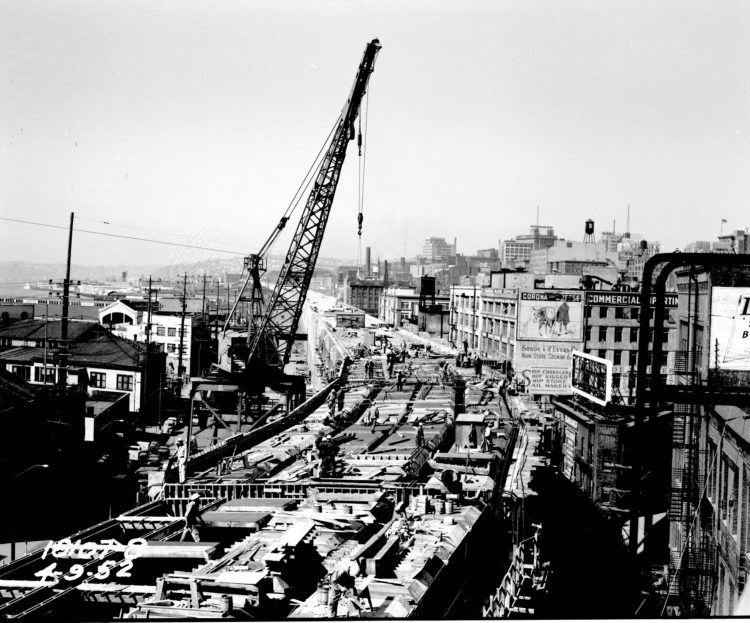
Weasel’s Paradise
The lack of traffic did make getting around much easier. We could jaywalk with much more impunity. We were doing just that, ambling up Western Avenue, just out of the hulking shadow of The Viaduct, past the 619 building – a previously wonderful, old industrial building chocked full of artist’s studios. That only lasted until a few years back when the city declared the entire place unsafe, ran out scores of long-time artists in residence like so many bums . . . then turned right around, sold it to developers who renovated the place, jacked up the rents, and made money as quick as their Seattle ancestors sold gold panning equipment for 1,000 percent over retail 120 years ago.
Screwing people over, even if they are literally your neighbors, is a fine, fine Seattle tradition. It dates back to the founders of the place, the Mercers and the Dennys et al. when they twisted the Native Americans out of literally everything they had. And don’t get me started on how they treated Tacoma. Or that time they nearly started a war with Canada because the Mayor stole some totem poles from Vancouver.
“So where’d everybody go to?” I asked about the former inhabitants of the 619 Building.
“Georgetown, ” Blaine said. “Or Tacoma. Or Ballard.”
I was thinking about this eternal struggle of artists, of how you are always looking for cheap studio space, when Blaine suddenly stopped and turned to his left, “Hey, there’re people walking on The Viaduct.”
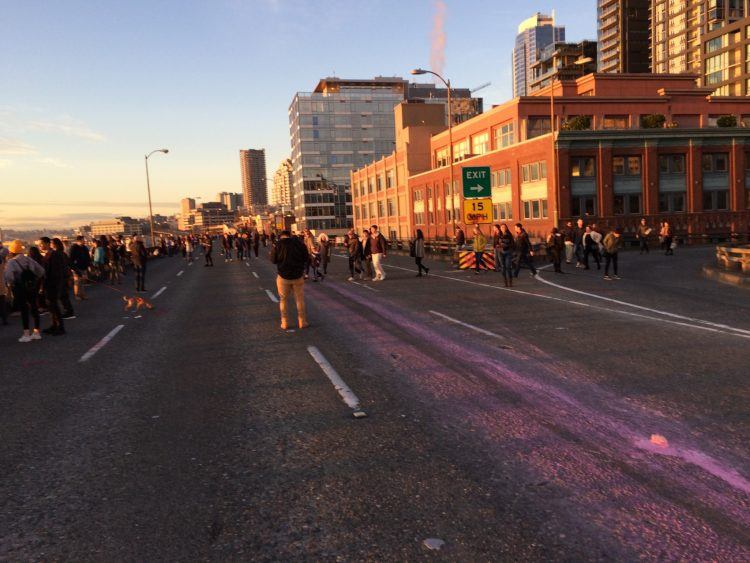
Jesus Is Just Alright
There were a bunch of people, wandering on what used to be, and I mean less than 24 hours ago, a sort of junior freeway, three lanes northbound, and three lanes southbound on the lower deck. Now, it was completely closed off. Soon, within days, the jackhammers and big claws and such would start tearing into it like sharks into a whale carcass. Some months in the future, it will be completely gone.
Blaine and I glanced at one another, but we didn’t even have to say it. We just started walking and working our way up to the Seneca Street off-ramp, about three-and-a-half blocks away. Here’s a funny thing about Seattle: The big streets downtown are named, South to North, Jefferson, James, Cherry, Columbia, Marion, Madison, Spring, Seneca, University, Union, Pike, and Pine, their first letters matching in pairs: J, C, M, S, U and P. Or “Jesus Christ Made Seattle Under Protest.”
Yes, they did it on purpose. Yes, it was the idea of “city leaders.”
See, we’ve always been like this.
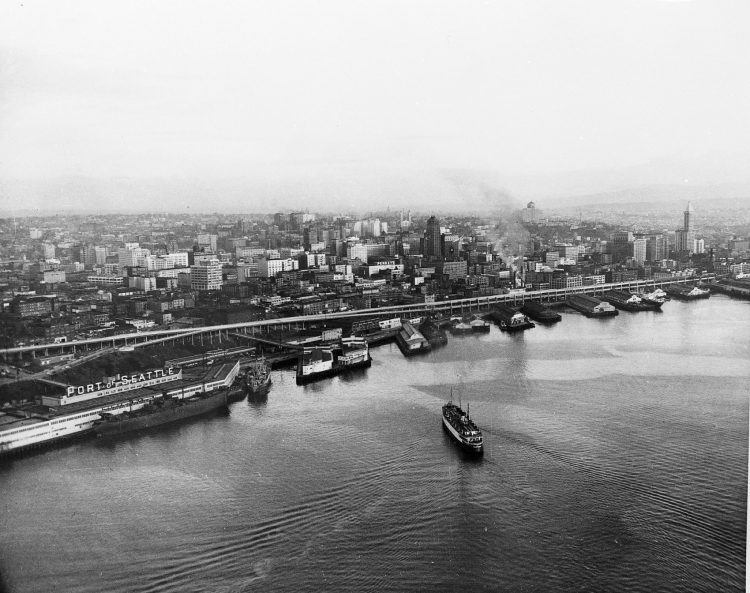
Middle Earth, Grunge Bands & Tech Billionaires
As we approached the Seneca off-ramp – one of only two ways off The Viaduct once you’re driving on it – we could see more people milling around on the upper deck. 100 . . . 150 . . . 200 . . . a lot more than I expected. At the bottom of the ramp where it meets First Avenue were sections of cyclone fence, and some not-very-threatening yellow tape admonishing us with “\\\DANGER///CONSTRUCTION///” There were a dozen or so PG&E workers severing power lines, a couple of bored cops, and a gap just big enough to walk through.
It wasn’t even a question. Over the years, Blaine and I have broken into so many parking garages, derelict buildings, movie shooting locations, punk venues (later escaping from those same punk venues), that blatantly disrespecting the authority of a length of yellow tape was easy. Besides nobody batted an eye.
We walked up the slight slope and onto the road deck itself. This is always a surreal experience. I should mention, this is not the first time I’ve done something like this, just the first time in this location. From a walking perspective, the place seemed wide open and flat.
You’re about 100 feet up in the air, facing directly West, right into the sunset over Alki Point in West Seattle. Sure, the weather is terrible and the city is screwed up, but it is very pretty around here.
Picture Middle Earth only with grunge bands and tech billionaires, and you’ll get the picture.
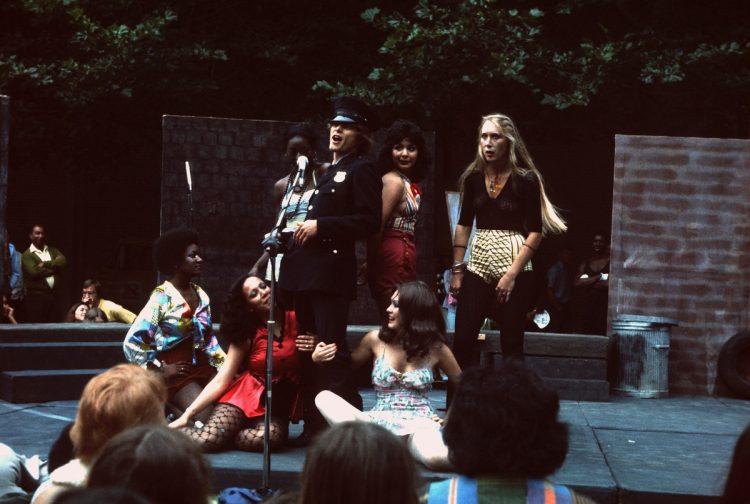
The Abyss of Seattle
Blaine stops and looks down at an expansion joint – I’m sorry, I mean he stopped and looked down through an expansion joint. Yes, it was cold, but not that cold. You could clearly see through the upper deck, then through the lower deck, and then to the surface of Alaskan Way below. The gap was huge, easily the width of my hand. Big pieces of the angle iron that faced the expansion joints were missing. Divots on either side of the gap were as big as loafs of bread. The road deck was rutted and grooved. There was a pothole deep enough to swallow my entire right foot.
And it wasn’t just this section, it was the entire length of The Viaduct – on both decks – that was chewed up like this.
Now on top of this, add a constant drizzle of rain on a 41 degree “day” and 10,000 angry, late, muddled, timid, unfocused, distracted (“the view”!), confused drivers, and you can imagine the Mad Max like texture a daily commute would bring. And with all those divots, potholes, expansion joints, poor expansion joints, lethal expansion joints, and sometimes good expansion joints, the grooves, ruts, spray from semi trucks and buses, and a road surface made out of greasy concrete and stone aggregate – well, you can guess what grip and traction were like.
And yet, overall, day-to-day usability is not what led to the demise of The Alaskan Way Viaduct.
Viaduct Elegy: Chapter Two: The New Colossus here.
Follow Tony Borroz on Twitter: @TonyBorroz. For more historic photos of the Alaskan Way Viaduct and the city of Seattle, visit the Seattle Municipal Archive’s Flickr page.

